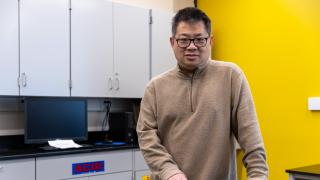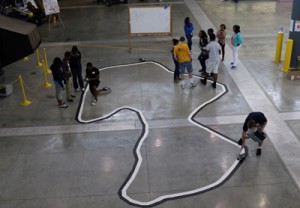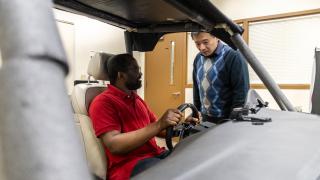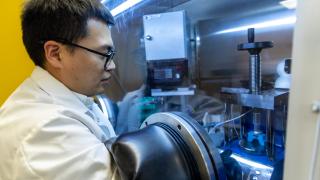

They aren’t old enough to get behind the wheel yet.
But that didn’t stop a group of local high school students from thinking about what’s next in driver assistance technology. The students were on campus Wednesday as part of the Michigan Introduction to Technology and Engineering (MITE) program for a hands-on workshop dedicated to autonomous vehicles.
The work makes sense for a generation of millennials who often are more interested in connecting virtually than driving to meet their friends.
“Texting and driving is one of the single largest contributors to automobile accidents for early drivers and experts know these two functions cannot safely exist while drivers are focused on controlling the vehicle,” said Mark Crawford, a research scientist at Ford and UM-Dearborn Ph.D. candidate, who led the program. “Self-driving cars may help address this problem by handling the driving and freeing drivers to engage in other activities.”
On the agenda for the afternoon? Students were tasked with building a system to assist drivers in traffic jams.
“When you’re in a traffic jam you’re thinking, ‘I’m tired. I don’t really feel like dealing with stop-and-go traffic. I’d like the vehicle to drive itself,” Crawford said. “We’re working on that at Ford with a feature called Traffic Jam Assist and we’ll do something similar today.”
They worked with robotic cars using Lego Mindstorm kits. Students built their cars, created the test environment, adjusted the software on the fly—all as part of the design process. And in the end they created their own traffic jam to test their final products.
The workshop was a condensed version of a six-week program UM-Dearborn partnered with the College for Creative Studies to run in the spring. The Automotive Design Experience for Area High School Students offered a deeper dive into automotive design with a focus on the topic “Being Mobile with Millennials.”
The idea behind both the MITE program and the CECS Experience is to expose student participants to the creative, intriguing, and enjoyable aspects of engineering and technology. We’re trying to inspire the pursuit of STEM careers by providing outreach opportunities that encourage real-world experiences in critical thinking, innovation, and leadership skills," said Jeanne Girard, director of the CECS Extended Learning and Outreach Office. "UM-Dearborn understands that an educated and skilled workforce provides a solid foundation for both the business sector and the communities where we live."



